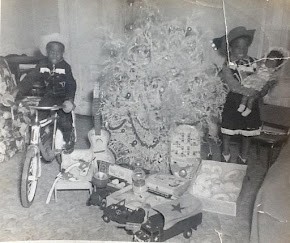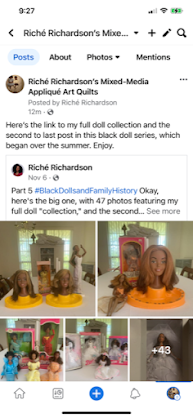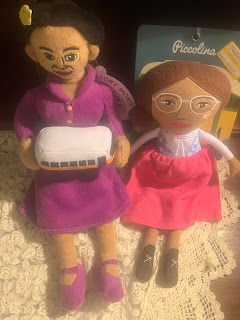Here are the 5 posts from the first part of a summer series from my art quilt page related to the long history of collecting dolls among some of the women in my family, including many black dolls.
Part 1: #BlackDollsandFamilyHistory Several times, my grandmother Emma Lou Jenkins Richardson told me that when they were girls, which was during the twenties, she and her sister Janie Mae Jenkins Reese accidentally discovered the beautiful black dolls that their Aunt Vinnie Jenkins Russell had hidden in a trunk, which they received as Christmas gifts days later. Aunt Vinnie also gave them the tea set of her beloved daughter Amanda, who passed away during childhood in the late 19th century. As a woman in Montgomery, Alabama, she and my grandfather enjoyed buying toys to surprise my mom, uncle and aunt. She also bought lots of dolls for my mom and aunt, black dolls from the store of a Jewish man, she said, as pictured in this photo of my mom and uncle dressed up in cowboy outfits at Christmas. I’ve discussed and the discourse on preferences for white dolls and self hatred so pervasive in black communities, but have a personal story that’s been very different from that, certainly not one in which girls grew up preferring white dolls. My grandmother had a lifelong love for dolls, ensured that the over 125 dolls I had growing up were preserved, and she and my mom continued adding to it, even after I went to college and they became a distant memory. Dolls have also been collected and treasured by several members of our extended family, along with other interesting things. For example, my mom well remembers the beautiful and elegant porcelain doll collection of my grandfather’s Cousin Ludie Meadows on display, dolls dating back to the nineteenth century, a woman who faithfully went to the mass meetings like other relatives of her generation, and who attended the March on Washington in 1963. As a child, my mom took ballet and tap. On Saturday mornings, she would attend Girl Scout activities, and then get together with her cousins Jackie Boswell, Beverly Robinson and others to play with their Barbie dolls. My preteen years were very similar, with either choir rehearsal with the Tender Golden Voices at my Church, Maggie Street Baptist, or Girl Scout meetings. Afterwards, my friend Liletta Nunnery and I always looked forward to going to Godfather’s pizza for lunch for mini combos, or Chuck E. Cheese’s, to the mall with our moms, and would then play with our Barbie dolls. She, her other best friend and Barbie playmate Tiffany Kennedy, with whom the fellowship was very similar, and I have often talked about what blessed times these were. I LOVE the beautiful scene in Beloved when Sethe buys the fabric, lace trims and black doll for her daughters once they are reunited as a family. There is such deep meaning there.

Part 4, #BlackDollsandFamilyHistory At age 12, I adored Michael Jackson like all of my friends. I won first-place prizes in citywide short story and essay competitions in Montgomery. I was busy collaborating with one of my classmates at St. John to draft the book of short stories we hoped to publish by age 15, as we read various literary classics. I was also gearing up to campaign and make speeches in a mock election in our 7th grade class for President of the United States. I had just graduated from my poise-charm class at Gayfers Department Store, and loved being a Jr. Gayfer Girl, which meant receiving store discounts and being recognized with this group at Gayfers’ annual Back-to-School Fashion Show, which highlighted the models on their teen board. My family had lost three of my grandmother’s siblings to cancer, and I had made countless daily hospital and home visits with my grandparents to see and support them from the time I was 9. My grandfather set up scaffolding and spent the summer months painting the living room and dining room, and by the holidays, my family was fully focused on preparations for my Aunt Pam’s wedding, whose colors were red and green in keeping with the season. My role was to be fitted at Gayfers for the tea-length green dress I had to wear as a one of 2 candle lighters in the ceremony, whose role it was to walk down the aisle bearing one of the long torches to help light all the white candles on the gold arch under which the vows would be exchanged. My dress was designed to match the beautiful red bridesmaid evening gowns, and to complement the green dresses of the matrons of honor. I was anxious to get my part just right, and excited to wear the kitten heel shoes, which had been dyed to match my dress. As Christmas got closer and closer, my other major worry was not seeing any boxes under our Christmas tree that looked like they could be Barbie dolls. Day after day, as the presents grew, I spotted not a one. My cousin and I were told not to touch or go near the tree to arrange anything, but daily, he’d see me slow down, look at it nervously from across the room, and crack up laughing at me and teasing me about “not having any Barbie dolls.” I just couldn’t believe it. But I turned the joke right back on him when he began to sweat it after he did something that irked them and was told by my uncle and aunt that another thing and he wouldn’t get the remote- controlled race car he wanted. The first formal photos for the wedding were taken at home in front of our Christmas tree, gorgeous images of my aunt with each of my grandparents. But my main interest in that tree had to do with what seemed not to be under it. My aunt’s wedding was an elegant formal affair and came off beautifully. The reception had been held in the church’s Fellowship Hall because she wanted no alcohol served at her wedding. Like many young women in the South, she had subscribed to Brides magazine for years and read it on a monthly basis, so every detail reflected her extensive knowledge. My grandparents followed up the wonderful reception, which had a gorgeous wedding cake, as well as a groom’s cake and delicious food buffet, coordinated by 25 hostesses weating beautiful red dresses to complement the bridesmaids, with a smaller family buffet dinner at home. The next day, the dining room was full of the wedding gifts, and the bride and groom arrived to open them in front of our family. As the pieces of the beautiful China pattern from Gayfers and other lovely gifts were opened and stacked up all around, my mind was still very much on my Barbie dolls. My grandmother was still kind of upset with me because I didn’t change my dress when she asked me to, and a cousin in our extended family in town for the wedding threw a pillow at me while I was holding a glass Coke, which spilled down the front of it the night before. Christmas was just over a week away, and it still looked like I had not a one doll. By that point, I resigned myself and tried my best to accept it. My cousin and I made a deal that I would tell my mom she should buy him the race car as his gift, and he’d ask his parents to buy me a Barbie doll as mine. That plan gave me a little hope. Day after day went by, and as the presents stacked up, still, not a one looked like it could be a Barbie box. Not even by Christmas Eve! The next morning, as the family opened gifts, I was determined to try my best to enjoy everything, despite my disappointment. After opening my first few gifts, including things like a Calligraphy pen set, it was a big shock and surprise to open a box, and within that box, to see a Barbie box! My mom had boxed and wrapped up all the Barbie dolls in shirt boxes. Just wow! It was one of the best surprises ever. My mom really threw me off that year. Pictured here are my Barbie doll collection and 2 doll houses from back then. I had a fashion doll trunk with lots Barbie clothes manufactured by Mattel, but the process of sewing, knitting and crocheting clothes for my dolls was ongoing for me, and a lot of time went into that process. I also sewed, knitted and crocheted all the bedding ensembles and furnishings to decorate my Barbie townhouse myself, which is pictured here. My friend Liletta had her own similar Barbie dollhouse paradise in her room at home. Always, before our play began, we’d show each other the latest items we’d made and inspect each other’s workmanship. Here are some photos of my mainly black Barbie doll family and world back then, who by then, were pretend “residents” in Beverly Hills, California.
Part 5 #BlackDollsandFamilyHistory Okay, here's the big one, with 47 photos featuring my full doll "collection," and the second to last post in this series. Growing up, and from my early childhood, I had a range of dolls of varying types with as many as 115 back then. Some were damaged and discarded along the way, like my first Baby Alive, whom I at 6 naively fed Play Doh after the food packets ran out. At every stage of development, I had lots of toys and games growing up, every conceivable thing to intellectually stimulate me, plus microscopes, 2 telescopes, 2 guitars, erector sets, keyboards, and still have a few of my toys, though my dolls were the main toys kept. A tall Walking Doll from my uncle and aunt, along with a Sunshine Family dollhouse, the Bionic Woman, Superstar Christie Fashion Face and Candi were other types of dolls I received as a child beyond baby dolls. At age 10, my activities were choirs such as the one at church and the Singing Samaritans at school, along with Girl Scouts. Playing school and pretending to be a teacher made me happiest, and I was beginning to write songs and poetry, sew and crochet, while trying hard to crack the Rubik’s Cube. On that, I was competing with my grandfather and Uncle Richard on this latest puzzle, one of many that my grandfather encouraged me to take on, who loved to work Puzzle books in his spare time, and had been proud of how fast I could work puzzles when I was a baby. That year, my Christmas list included Golden Dream Christie, a trunk and car for her, a Knitting Machine, and a Quiz Whiz, and I received those things, plus a Quiz Whiz Challenger and lots of other toys and games, including various electronic ones. It was at this juncture that Barbie assumed center stage in my world of play, and an earlier post in this series highlighted images of my 2 Barbie doll houses from back then, along with my Barbie dolls. At the mall, one of my 2 best friends with whom I mainly played, Liletta, during our preteen years, and I would go to see the latest Barbie dolls at Circus World toy store whenever we were at Montgomery Mall with our moms, and at Eastdale Mall, would go to Pizitz, where we loved to see the Dolls of the World Collection in their toy department. At age 12, I got an original Cabbage Patch Kid when they came out ,and had already begun to experiment with making miniature types in that genre once my grandparents bought me a Xavier Roberts pattern book from Gayfers at age 11. At age 14, my Grandmother Emma Lou Jenkins Richardson learned that Mrs. Essie Thomas, one of our neighbors down the street, was making dolls and immediately ordered 2 “adoption dolls” for me from her for $60 each. Just a year later, and after my cousin Keri was born, my Aunt Pam visited Mrs. Thomas and helped design one for her baby daughter, who was about six months old at the time. Keri’s first birthday party was held at the Woodmere Clubhouse and had a Cabbage Patch Kids theme, where the full collection was placed. At age 16, I also bought souvenir dolls on school trips I took back then to Cheha State Park when we climbed Mt. Cheha, and on a trip to New Orleans. My beloved Grandmother would sometimes surprise me after school as a teen in high school by leaving interesting dolls for me on my bed that she spotted in her shopping forays out with friends, and also began to buy me porcelain dolls from displays at the grocery store. I kept several black porcelain dolls on display in my dormitory rooms throughout my college years, along with one of the dolls that I had made. Both she and my mom continued to add dolls to the “collection” long after my interest receded and focus shifted to other things. My grandmother and her sister loved the black dolls that their Aunt Vinnie bought for them, and my grandmother bought my mother and aunt mostly black dolls as children. Most of mine were as well, though never all. I view dolls as time capsules and have been intrigued by their adaptations over history. I still have the vast majority of the dolls I grew up with and the vast majority that I’ve added over time fall within very specific categories; historical ones like the rag and bisque, a vintage Barbie that my grandmother bought me at a yard sale, dolls from Africa and the Caribbean (mainly from the Bahamas, and I do, incidentally, on my paternal side, have family roots in the Bahamas); porcelain dolls, story dolls, soft sculpture dolls, Barbie dolls, and various miniature and novelty dolls, etc. Among Barbie dolls, I’m mainly interested in the black "Superstar" collection from the late 1970s on, and types produced up to the mid-1990s, a collection mainly of dolls from my childhood era that the Spirit of the Lord placed it on my heart and led me to fill out just before they were becoming exorbitantly priced for hundreds and more on a market dominated by white collectors and enthusiasts. I replaced my Superstar Christie Fashion Face and Golden Dream Christie dolls and also collected an original Superstar Christie from 1976, along with various others in the series, added some from the aforementioned Dolls of the World, two original black Little People dolls by Xavier Roberts, and more recently, several Inspiring Women and wedding dolls. At this point, I have about 171 dolls in all, which are pictured in photo galleries here. Though many are still boxed and in mint condition, I'm far from being a serious doll collector, but am very casual in it. I’ve also pictured the 15 dolls that belong to my grandmother, aunt, Keri and Megan. Dolls are just another interesting visual layer in designing and staging a space focused on showcasing my Southern folk and fine art collections, one that primarily serves as an artist’s home and art studio. The Barbie theme also works well to invoke in my art studio because knitting and crocheting so many clothing and bedding items for my Barbie and dolls and making miniature soft sculpture dolls as a preteen paved the way to my eventual emergence as a quilt artist. My doll collection was to me what action figures and race cars were to the boys I grew up with, and once brought me a lot of joy, and so having reminders from childhood in the background here and there is nice nowadays. The selected list of dolls from my childhood, as many as whose official names I can remember, is posted in the comments. I was collaborating on a couple of local public black doll exhibits with other collectors here in Ithaca prior to pandemic, an idea it might be interesting to circle back to at some point.




























!!@!@@!@!@!@!@!@!@!@!@!embroidery digitizing service usa !!212 great service
ReplyDelete!
!
!
!
!
!
!
!!